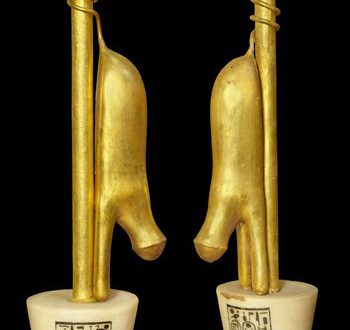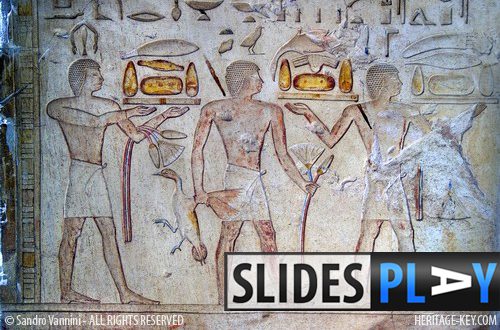 Discovered inside the Tomb of King Tutankhamun, inside black resin-covered wooden shrines which were accessible via double doors, were 34 ritual figures. Of significant importance during the ritual ceremony, these statuettes are believed to assist the King Tut’s passage to the afterlife. Upon discovering the shrines in KV62, the great explorer Howard Carter found only one of the boxes had been raided by tomb robbers, with the rest laying undisturbed since antiquity. The ritual figures are now housed inside Cairo’s Egyptian Museum and have been captured on film by Sandro Vannini, who has photographed Egypt’s greatest treasures including the famous Golden Mask of King Tutankhamun.
Discovered inside the Tomb of King Tutankhamun, inside black resin-covered wooden shrines which were accessible via double doors, were 34 ritual figures. Of significant importance during the ritual ceremony, these statuettes are believed to assist the King Tut’s passage to the afterlife. Upon discovering the shrines in KV62, the great explorer Howard Carter found only one of the boxes had been raided by tomb robbers, with the rest laying undisturbed since antiquity. The ritual figures are now housed inside Cairo’s Egyptian Museum and have been captured on film by Sandro Vannini, who has photographed Egypt’s greatest treasures including the famous Golden Mask of King Tutankhamun.
The greatest archaeological discovery of the 20th century, the inspiring tale of how Carter and his financier Lord Carnarvon uncovered the treasures of King Tutankhamun by working together is told by their modern day descendants the Earl and Countess in a video interview with Heritage Key (Watch this video).
‘Ritual Figures’ Slideshow
Heritage Key is working with Sandro and bringing his extensive catalogue of beautiful photography of Egyptian antiquities onto the internet, which make for stunning viewing for both the casual observer and the keenest budding archaeologist alike! To watch a slideshow of the Ceremonial Chariot, simply click any of the thumbnails below.
Explore KV62 for yourself in King Tut Virtual
But it doesn’t stop there, as you can also visit King Tut Virtual and see digital recreations of many of the famous artefacts from KV62, walk through the Valley of the Kings, explore the banks of the River Nile in Ancient Egyptian times and even see more of Sandro Vannini’s photography in the virtual gallery.
Sandro Vannini’s Photography
Sandro has spent over a decade in Egypt, photographing some of the most stunning archaeological finds in history, as well as hundreds of amazing tombs across Egypt. The experience gained and skills enhanced have given Sandro a natural flair for making these artefacts come to life in his photography. Obviously the equipment he uses is a key factor too, and for capturing the Ritual Figures of King Tut on film, Sandro employed the use of a Hasselblad ELD Ixpress 528C camera to take these images.
You can also see more of Sandro’s fantastic photography in his new book with the Director of the Supreme Council of Antiquities, Dr Zahi Hawass, “The Lost Tombs of Thebes:Life in Paradise” as well as reading about Sandro’s experiences of shooting the photographs in Thebes on Heritage Key, and watching the video about the Lost Tombs of Thebes featuring Dr Zahi Hawass and Dr Janice Kamrin.
Of course, not everyone would be able to make that trip to Cairo to see the beautiful artefacts that the Egyptian Museum holds, so Heritage Key brings Sandro’s stunning photography of the Ceremonial Chariot of the Tomb of King Tut. But it doesn’t stop there: you can visit virtual replicas of Tutankhamun treasures in the Heritage Key VX King Tut exhibition, which features a virtual replica of many other breath-taking artefacts such as the Golden Mask of King Tutankhamun.
Don’t miss out on new treasures!
This post is part of a series focussing on amazing photographs from ancient Egypt. Keep checking back as well keep adding new images by Sandro Vannini. To make sure you don’t miss out on any of the updates, simply subscribe by email to receive notifications when new images are uploaded. For the more digitally advanced, there’s also an RSS feed with updates available.
See More Amazing Photography by Sandro
Have a look at some of the other stunning photographs by Sandro Vannini here at Heritage Key:
- The Ceremonial Chariot
- External Trappings of the Mummy
- Cosmetic Jar with Recumbent Lion
- Golden Mask of King Tutankhamun
Ask Sandro
We’ll be sitting down with our favourite photographer for an extended chat soon, so if you have any questions for Sandro we’ll send the answers straight to you!
The Ritual Figures
 The small statues of King Tutankhamun showed him in a variety of positions and acts. The first of which, photographed by Sandro, show the boy king riding a papyrus raft, hunting an invisible hippopotamus with a spear or harpoon. The hippopotamus was considered by the ancient Egyptians to symbolise evil and disorder, because the evil deity Seth – according to Egyptian mythology – transformed himself into a hippo before being defeated in battle by the god Horus.
The small statues of King Tutankhamun showed him in a variety of positions and acts. The first of which, photographed by Sandro, show the boy king riding a papyrus raft, hunting an invisible hippopotamus with a spear or harpoon. The hippopotamus was considered by the ancient Egyptians to symbolise evil and disorder, because the evil deity Seth – according to Egyptian mythology – transformed himself into a hippo before being defeated in battle by the god Horus.  The statue is representative of King Tut restoring order to the Egyptian universe like a golden god, by hunting down the hippo.
The statue is representative of King Tut restoring order to the Egyptian universe like a golden god, by hunting down the hippo.
Carved from hard wood, and covered with gold leaf, he is shown in highly realistic detail taking a long stride forward, as he prepares to launch his spear. In his other hand is a coiled bronze rope, for capturing the defeated animal. The style of the statuettes reflects trends of the Amarna period – particularly the exaggeration of certain physical features.  It has been speculated that they may have originally been created as an image of Tut’s father, the “heretic pharaoh” Akhenaten, who founded Amarna.
It has been speculated that they may have originally been created as an image of Tut’s father, the “heretic pharaoh” Akhenaten, who founded Amarna.
The second statue shows King Tut astride a panther and wearing a tall crown, bearing a flail in his left hand and a staff in his right. The black panther represents the netherworld and the night sky, and by riding on its back, the boy king is able to navigate safely through the dangers posed by these, allowing him to be reborn in the coming morning. It has been suggested this figure was originally made for a Queen, due to the ample bust – possibly for Nefertiti.
 In a video for Heritage Key(Click to skip to the Video), Dr Janice Kamrin shows artefacts in the Egyptian Museum including the Ritual Figures, stating Another very interesting thing about these statues and a lot of the other pieces in the tomb is that they were not originally made for Tutankhamun.
In a video for Heritage Key(Click to skip to the Video), Dr Janice Kamrin shows artefacts in the Egyptian Museum including the Ritual Figures, stating Another very interesting thing about these statues and a lot of the other pieces in the tomb is that they were not originally made for Tutankhamun.  Some artefacts discovered in KV62 would originally have been created for another Kings’ funerary assemblage, suggesting King Tut’s unexpected demise.
Some artefacts discovered in KV62 would originally have been created for another Kings’ funerary assemblage, suggesting King Tut’s unexpected demise.
In some of the discovered Ritual Figures, the faces are evidently not those of King Tutankhamun himself, although reconstructions show that he had some effeminate features. Some details, such as the shape of the belly button and size of the bust are indicative of gender, but in many ways it can be difficult to determine male statues from females.
HD Video: King Tut’s Treasures: The Ritual Figures
(Read the transcript on the video page)
If you liked this video, you can look at the Heritage Keys video page for all our videos to date and see more of archaeologists working in Ancient Egypt. Additionally, you can find out more about Ancient Egypt here at Heritage Key, and if you want to do some discovery of your own, you can explore KV62 – King Tutankhamun’s tomb – in 3D in our exciting virtual experience! Also be sure to keep up to date on all new postings about Sandro’s photography from Egypt by subscribing to our feed, simply by entering your email address above.





